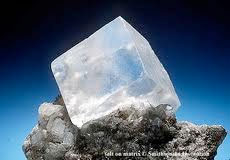Salt Intro
 At the most basic level table salt is a compound composed of two elements, sodium (Na
+) and chloride (Cl-), which through the miracle of ionic bonding form what is called
sodium chloride. In general chemistry any chemical reaction in which an ionic bond is
formed through a reaction involving an acid and base creates a compound called "salt".
At the most basic level table salt is a compound composed of two elements, sodium (Na
+) and chloride (Cl-), which through the miracle of ionic bonding form what is called
sodium chloride. In general chemistry any chemical reaction in which an ionic bond is
formed through a reaction involving an acid and base creates a compound called "salt".
Sodium chloride (NaCl) forms colorless, cubic crystals, similar to blocks stacked on top
of each other. The ionic bond formed in salt is what
allows for the great salt chemistry we see in our
bodies and nature. These bonds and the electrons
surrounding the atoms (Sodium and Chloride)
create other bonds and reactions with other
elements in nature. One area in particular is with
water balance within our bodies. Where there is
salt, water will soon follow. If we consume too
much salt, water will move out of our cells to
balance the salt concentration inside and outside
of our cells. If this balance tilts too far from middle
we can become sick and have problems with blood pressure and electrolyte balance.
Sodium chloride is frequently found in nature as the mineral halite (to learn more about
the mineral click here), or rock salt. Some common places to find halite are the Great
Salt Lake in Utah, the Dead Sea, and of course where our team is running, the largest
salt flat in the world, the Salar de Uyuni. There are many locations throughout the world
where you can find salt, there may even be a salt flat, salt water basin, or salt mine near
you.
There are many uses of salt which will be discussed in detail in later posts. Salt is such
a key component in peopleʼs lives that annually 200 million tons of salt is produced, with
the United States and China being the leading producers. Furthermore, civilizations
have formed around salt and salt has had a critical impact on human history.
Now that you have a basic chemical understanding of salt we will move onto salt in
history and how these two simple elements (sodium and chloride) have come together
to shape human history.
 At the most basic level table salt is a compound composed of two elements, sodium (Na
+) and chloride (Cl-), which through the miracle of ionic bonding form what is called
sodium chloride. In general chemistry any chemical reaction in which an ionic bond is
formed through a reaction involving an acid and base creates a compound called "salt".
At the most basic level table salt is a compound composed of two elements, sodium (Na
+) and chloride (Cl-), which through the miracle of ionic bonding form what is called
sodium chloride. In general chemistry any chemical reaction in which an ionic bond is
formed through a reaction involving an acid and base creates a compound called "salt".